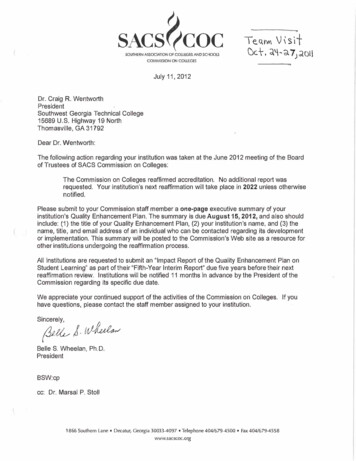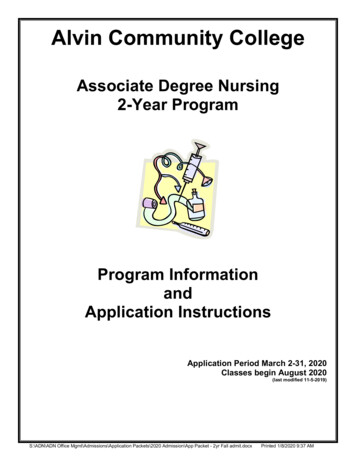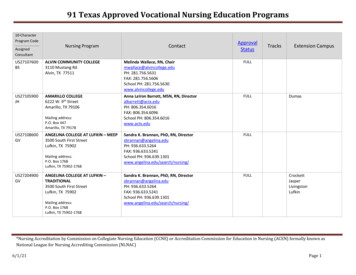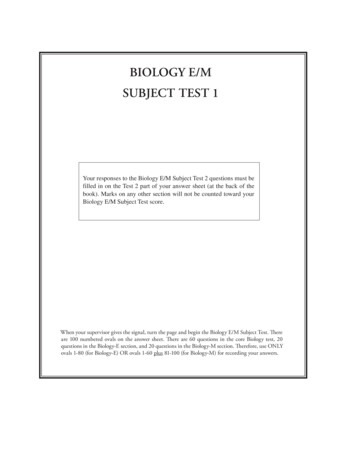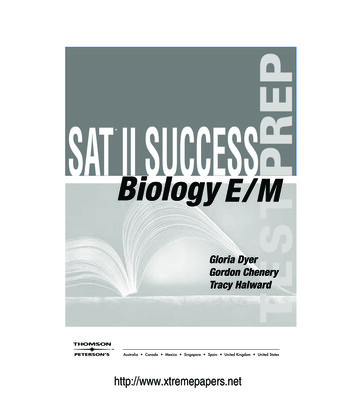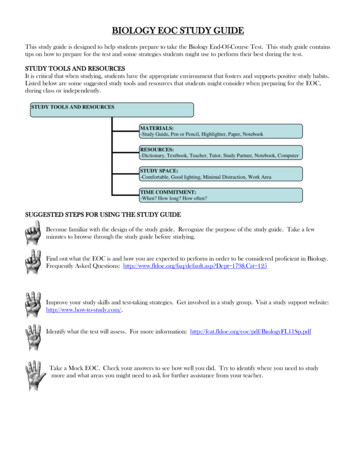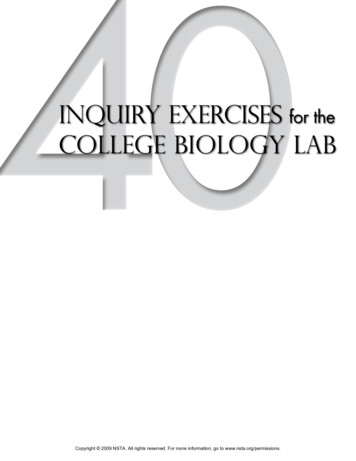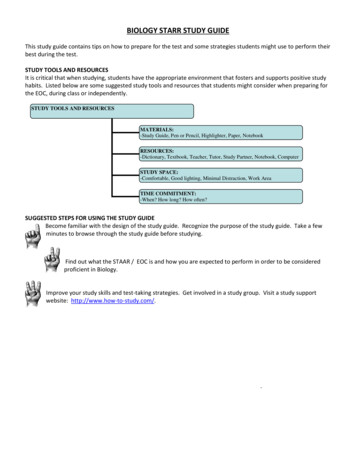
Transcription
BIOLOGY STARR STUDY GUIDEThis study guide contains tips on how to prepare for the test and some strategies students might use to perform theirbest during the test.STUDY TOOLS AND RESOURCESIt is critical that when studying, students have the appropriate environment that fosters and supports positive studyhabits. Listed below are some suggested study tools and resources that students might consider when preparing forthe EOC, during class or independently.STUDY TOOLS AND RESOURCESMATERIALS:-Study Guide, Pen or Pencil, Highlighter, Paper, NotebookRESOURCES:-Dictionary, Textbook, Teacher, Tutor, Study Partner, Notebook, ComputerSTUDY SPACE:-Comfortable, Good lighting, Minimal Distraction, Work AreaTIME COMMITMENT:-When? How long? How often?SUGGESTED STEPS FOR USING THE STUDY GUIDEBecome familiar with the design of the study guide. Recognize the purpose of the study guide. Take a fewminutes to browse through the study guide before studying.Find out what the STAAR / EOC is and how you are expected to perform in order to be consideredproficient in Biology.Improve your study skills and test-taking strategies. Get involved in a study group. Visit a study supportwebsite: http://www.how-to-study.com/.DESIGN OF THE BIOLOGY EOCAdministration Dates: The EOC will be given at the end of each semester – a December and a May test date.Administration Time: You will be given ample time to complete your exam.Question Format: The Biology EOC test contains critical thinking multiple choice questions.
PREPARING FOR THE STAARNOTE: Preparing for the Biology STAAR test will take time, effort, and practice. You cannot prepare for the BiologyEOC test in one night!In order to do your best on the Biology STAAR test, it is critical that you take the time to prepare and develop studyskills. First, you need to make sure that your classroom experiences and study time are used efficiently andproductively. Second, it is most helpful to know some general test-taking strategies to ensure that you will achievethe best score.Here are some important questions to ask yourself when developing your study skills. Your answers may help youdefine some areas in which you need to make some improvements.1. How would you describe yourself as a student?2. What are your study skills strengths and/or weaknesses as a student? Whatmethods help you the most?3. How do you typically prepare for a biology test?4. Compare an ideal study situation (environment) to your actual studyenvironment.5. What can you change about the way you study to make your study time moreproductive?Study skills can actually be divided into separate target areas: time management, organization, and active participation.Use these suggestions to help you improve your study skills and your study environment.
TIME MANAGEMENTDo you have a plan for studying?Without a plan, many studentsdon’t meet their goals. Here aresome strategies to consider whendeveloping a study plan.- Set realistic goals for each studysession- Chart your progress- Study for a reasonable amountof time (cramming is notrecommended)- Take frequent breaks- Be consistent – establish aroutine- Study the most challengingcontent FIRST- Build in review time at the endof each study session- Evaluate your accomplishments- Reward yourselfORGANIZATIONACTIVE PARTICIPATIONAre you organized? Do you have aplace to study and do you have thematerials and resources you need tostudy? Get organized andprepared!What is active studying? It can beanything that gets you to interactwith the materials you are studying.Active studying allows you to staymore alert and be more productivewhile learning new information.- Establish a study area that hasminimal distraction- Gather your materials inadvance; keep them ready foreach study session- Develop a study plan andfollow it consistently- Find a way to access thenecessary resources (i.e.,computer)- Carefully read the informationand then DO something with it- Mark important points with ahighlighter, circle them with ared pen, write notes on them,or summarize in your ownwords, read out loud- Ask questions; write themdown and actively seek answers- Create sample test questionsand answer them- Find a friend who is alsopreparing for the same test andquiz one anotherTEST-TAKING STRATEGIESThere are many test-taking strategies that you can use before and during a test to help you have the most successfultesting situation possible. Here are some questions to help you take a look at your test-taking skills.1. How would you describe your test-taking skills? List the strategies that you already knowand use when you are taking a test.2. How do you feel when you are taking a test? List test-taking behaviors you use whenpreparing for and taking a test that do not contribute to (but distract from) your success.3. What would you like to learn about taking tests?
SUGGESTED STRATEGIES TO PREPARE FOR THE BIOLOGY EOC TESTThere are some general strategies that you can use to prepare for any test, including the Biology EOC test. These strategiesinclude:--Pay attention to your daily / weekly grades in your science class.Focus on key factors:a. In which areas of science are you successful?b. What has kept you from achieving higher scores?c. What would you change to allow you to achieve higher scores?Remove or minimize any obstacles that might prevent you from studying – or focusing.Be prepared.Know what standards / skills are being assessed and then practice understanding and using those skills.Know the difference between reading and skimming; you will need to read in detail first, skim later.Don’t wait until the last minute. Begin early and pace yourself.Strategies to Use the Day Beforethe Biology STAAR Test- Review what you have learnedfrom the study guide.- Review general test-takingstrategies.- Review content-specificinformation that showsconnections and relationships(lists, diagrams, graphicorganizers, etc.).- Focus attention on the areasthat you are most in need ofimproving.- Read short summaries of eacharea to revitalize yourmemory.- Get a good night’s sleep.Strategies to Use the Morning ofthe Biology STAAR Test- Eat a good breakfast (protein long-lasting energy).- Dress appropriately (dresscomfortable and in layers; hotor cold extremes can affectyour performance).- Arrive for the test on time.- Skim notes, text, vocabulary,and/or diagrams.Strategies to Use During theBiology STAAR Test- Focus on the test. Block outwhat is going on around you.Listen carefully to directions.- Budget your time. Allocatetime to work on eachquestion.- Take a quick break. Put yourpencil down, take a deepbreath, close your eyes – oneminute – then resume.- Practice positive self-thinking.- Mark key ideas in your testbooklet and come back tothem.- Read each questioncompletely. Read answerchoices completely. Followthe process of selection andelimination.- Check your answers when youhave finished the test.UNDERSTANDING THE BIOLOGY STANDARD COURSE OF STUDYEach question on the Biology EOC test measures an objective, or a combination of objectives, from the curriculum goals. Thegoals are important for several reasons. Together they represent the ability to understand and communicate biologicalconcepts. Another, more significant, reason is test preparation. The best way to prepare for any test is to study and know thematerial assessed on the test. The chart below lists the major goals and individual objectives for the Biology STAAR exam.NOTE: Biology is a very broad subject. To provide you with the most information related to Biology, it would require hundredsof pages. This study guide provides you with some specific, summarized information that you will need to know for the BiologyEOC test and it will help to facilitate your study efforts. Your Biology textbook will be your best source of additional information
INFORMATION TO STUDY FOR THE BIOLOGY EOC TEST(Lists, Diagrams, Graphic Organizers, Key Vocabulary, Distinctive Categories, etc.)You should plan to study / review the content for ALL the goals and objectives. In this section, you will find contentspecific information that shows connections, relationships, and key vocabulary for each of the five major goals.GOAL 1: Design and conduct investigations to demonstrate an understanding of scientific inquiry. Scientific InvestigationsHypotheses, Variables, Controls, Measurement / Tools, Data, Charts / Graphs, Communication of FindingsInquiry Activities, Research, Statistical Techniques, Laboratory Reports, Sources of Error, Community InvolvementSafety Procedures, Laboratory / Field Studies, Potential Hazards, Manipulate Materials / EquipmentAnalyze Reports, Scientifically Literate Viewpoint, Adequacy of Experimental Controls, Replication, InterpretationsHYPOTHESIS: tentative explanation for an observation,phenomenon, or scientific problem that can be tested by furtherinvestigationVARIABLE: to vary or changeINDEPENDENT VARIABLE: a manipulated variable in anexperiment or study whose presence or degree determines thechange in the dependent variableDEPENDENT VARIABLE: the observed variable in anexperiment or study whose changes are determined by thepresence or degree of one or more independent variablesCONTROL: a standard against which other conditions can becompared in a scientific experimentSOURCES OF ERROR IN EXPERIMENTS:- Instrumental error (lack of calibration)- Personal error (inaccurate observations)- Sampling error (sample size too small or not random)- Replication error (lack of consistency and accuracy)- Experimental design- Measurement error (lack of accuracy and project scientific method.shtmlBASIC STEPS FOR AN EXPERIMENT:1.2.3.4.5.plan the research including determining information sources, research subject selection, and ethical considerations for theproposed research and method,design the experiment concentrating on the system model and the interaction of independent and dependent variables,summarize a collection of observations to feature their commonality by suppressing details (descriptive statistics),reach consensus about what the observations tell us about the world we observe (statistical inference),document and present the results of the study.TYPES OF OBSERVATIONS:Qualitative – described by words or termsrather than numbers and including subjectivedescriptions in terms of variables such as color,shape, and smell; often recorded using terms,photographs, or drawingsQuantitative – numerical values derived fromcounts or measurements of a variable;frequently require some kind of instrument usein recordingREPLICATION OF EXPERIMENTS: WHY?- shows how variable the response can be- limited resources may affect results; need to determine a compromise betweenresources and methods- need to show a difference between pairs of means- reliability of results- consistency of methods and procedures and equipment- analysis of data and interpretation of data to form conclusions- ability to form a scientifically literate viewpoint with valid supporting data
GOAL 1: Cells Structure and Functions of Organic Molecules (carbohydrates, proteins, lipids, nucleic acids)Structure and Functions of Cells, Cellular Organelles, Cell Specialization, Communication Among CellsCell as a Living System, Homeostasis, Cellular Transport, Energy Use and Release in Biochemical ReactionsStructure and Function of Enzymes, Importance in Biological SystemsBioenergetic Reactions, Aerobic / Anaerobic Respiration, PhotosynthesisORGANIC MOLECULES:Organic compounds contain carbon and are found in all living things.- Carbohydratesmajor source of energy and include sugars and starchesmade up of carbon, hydrogen, and oxygen with a 2:1 ratio of hydrogen to oxygenplants and animals use carbohydrates for maintaining structure within the cells- ProteinsNitrogen-containing compounds made up of chains of amino acids20 amino acids can combine to form a great variety of protein moleculescan compose enzymes, hormones, antibodies, and structural components- Lipidswater-insoluble (fats and oils)made up of carbon, hydrogen and oxygen; composed of glycerol and fatty acidprovide insulation, store energy, cushion internal organs, found in biological membranessaturated (with hydrogen, single bonds, see example ) and unsaturated (double bonds)- Nucleic Acidsdirect the instruction of proteinsgenetic information an organism receives from its parentstwo types: DNA (deoxyribonucleic acid) and RNA (ribonucleic acid)CELL ORGANELLES:- Chloroplast – capture solar energy forphotosynthesis (plant cells, some algae)- Golgi Body – package, distribute products- Lysosomes – digests excess productsand food particles- Mitochondria – transform energy throughrespiration- Nucleus – contains DNA which controlscellular activities- Ribosome – produce proteins- Vacuole – store substances- Cell (plasma) membrane – phospholipidbilayer that protects and encloses the cell;controls transport; maintains homeostasis- Cell wall – rigid second layer that protectsand encloses the cell (plant cells andsome bacteria)- Cytoplasm – fluid-like substance thatcontains various membrane-boundstructures (organelles) that performvarious functions- Endoplasmic Reticulum – site ofchemical reactions- ROUGH: contains ribosomes- SMOOTH: lipid production- Cytoskeleton – provides internal structure- MICROFILAMENTS: fibers- MICROTUBULES: cylindersCELL TYPES:- Unicellular – organism that exists as asingular, independent cell- Multicellular – organism that exists asspecialized groups of cells; cells areorganized into tissues that perform thesame function; tissues form organs andorgans make up an organ system- Prokaryote – has nuclear material inthe center of the cell, but is not enclosedby a nuclear membrane; no membranebound organelles; found in bacteria andblue-green bacteria- Eukaryote – contain a clearly definednucleus enclosed by a nuclearmembrane and membrane-boundorganelles; found in plants, animals,fungi, and protistsCARBOHYDRATE(Sugar – Glucose)PROTEIN(One Amino Acid)LIPIDNUCLEIC ACID(One Nucleotide)CELL THEORY:- The cell is the basic unit of life.- All organisms are composed of cells- All cells come from pre-existingcells.CELL SPECIALIZATION:- cells tissues organs organ systems organism- each cell performs a specific function for each tissue or organ- as cells mature, they shape and contents change- as cells become specialized they may contain organelles that are NOTcommon to all cells (for example: plastids, cell wall, vacuole, centriole)- design and shape of a cell is dictated by its function and the conditionsunder which it works- multicellular organisms exhibit greater cellular specialization, such as redblood cells, nerve cells, and gland cells
CELL TRANSPORT:- Passive Transport – movement of substances across the plasma membrane without the use of the cell’s energy (with the concentration gradient)1. DIFFUSION – movement of substances across the plasma membrane from an area of high concentration to an area of low concentration2. OSMOSIS – diffusion of water across the plasma membrane from areas of high concentration to areas of lower concentration3. FACILITATED TRANSPORT – a carrier molecule embedded in the plasma membrane transports a substance across the plasma membrane followingthe high-to-low concentration gradient- Active Transport – movement of substances across the plasma membrane that requires the use of the cell’s energy and carrier molecules; substancesare moving from an area of low concentration to an area of higher concentration (against the concentration gradient)1. ENDOCYTOSIS – large particles are brought into the cell2. EXOCYTOSIS – large particles leave the cell- HOMEOSTASIS – internal equilibrium; the plasma membrane regulates what enters and leaves the cell; a selectively permeable membrane only allowscertain substances to pass through- Effect of Concentration on a Cell1. HYPOTONIC – water moves in; cell bursts2. HYPERTONIC – water moves out; cell shrivels3. ISOTONIC – no net movement; cell maintains equilibriumHOMEOSTASIS: Self-regulating mechanism that maintains internal conditions (with individual cells and within organs, systems) Example: body temperature,respiration, nutritional balance, etc. Cells communicate their needs to each other mainly through their cell membranes by releasing chemical messengersthat, ultimately, tell the hypothalamus gland in the brain that a change needs to be made in the interstitial fluid. Since it is the ruler of homeostasis, thehypothalamus sends neural and chemical signals to other glands, tissues, organs, and organ systems to adjust the internal environment, the interstitial fluid,so that it is more suitable for all the cells at that particular time. And since we are always changing what we are doing, homeostasis needs to change alongwith our activities, both day and night. This constantly changing internal environment is the process of homeostasis.Negative Feedback: Glucose / Insulin levels in cellsPositive Feedback: Blood platelets / Blood clottingBIOCHEMICAL REACTIONS: chemical bonds are formed and broken within living things creating chemical reactions that impact the ability to maintainlife and carry out life functionsCellular Respiration – food molecules are converted to energy; there are three stages to cellular respiration; the first stage is calledglycolysis and is anaerobic (no oxygen is required); the next two stages are called the citric acid cycle and the electron transport chain andare aerobic (oxygen is required)C6H12O6 6O2 6CO2 6H2O ENERGY (36 ATP)Photosynthesis – plant cells capture energy from the Sun and convert it into food (carbohydrates); plant cells then convert thecarbohydrates into energy during cellular respiration; the ultimate source of energy for all living things is the Sun (in Chemosynthesis,organisms use sulfur or nitrogen as the main energy source)6CO2 6H2O ENERGY(from sunlight) C6H12O6 6O2ATP – ATP is a molecule that stores and releases the energy in its bonds when the cell needs it; removing a phosphate group (P) releasesenergy for chemical reactions to occur in the cell and ATP becomes ADP; when the cell has energy, the energy is stored in the bond whenthe phosphate group is added to the ADPATP ADP P ENERGYFermentation – when cells are not provided with oxygen in a timely manner, this process occurs to continue producing ATP until oxygen isavailable again; glucose is broken down; there are two types of fermentationLactic Acid Fermentation (muscle cells)Glucose Lactic Acid 2ATPAlcoholic Fermentation (plant cells)Glucose CO2 Alcohol 2ATP
AEROBIC AND ANAEROBIC RESPIRATION:Aerobic Respiration –requires the presence of oxygenrelease of energy from the breakdown of glucose (or another organic compound) in the presence of oxygenenergy released is used to make ATP, which provides energy for bodily processestakes place in almost all living thingsAnaerobic Respiration –occurs in the absence of oxygenbreakdown of food substances in the absence of oxygen with the production of a small amount of energyproduces less energy than aerobic respirationoften called fermentationseen as an adaptation for organisms that live in environments that lack oxygenCOMPARISON OF CELLULAR RESPIRATION, PHOTOSYNTHESIS AND CHEMOSYNTHESISCELLULAR RESPIRATIONPHOTOSYNTHESISCHEMOSYNTHESISFood Broken DownFood SynthesizedFood SynthesizedEnergy from Glucose ReleasedEnergy from Sun stored in GlucoseEnergy from Methane or Inorganic MaterialCarbon Dioxide given offCarbon Dioxide taken in(ex: H gas or Hydrogen sulfide)Oxygen taken inOxygen given offOrganisms often called chemotrophsProduces Carbon Dioxide and WaterProduces Sugars (Glucose) from PGALOrganisms called extremophilesDoes not require LightRequires LightLive in environments without oxygenOccurs in ALL Living CellsOccurs only in presence of ChlorophyllAnaerobic BacteriaOrganisms often called HeterotrophsOrganisms called AutotrophsHabitats: hydrothermal ventsENZYMES:Enzymes are special proteins that regulate nearly every biochemical reaction in the cell. Different reactions require different enzymes.Enzymes function to:Provide energy to cellsBuild new cellsAid in digestionBreak down complex molecules (“substrate” reactant)Catalysts (speed up chemical reactions without being used up or altered)Factors that affect enzymes: pH, temperature, and quantity
GOAL 4: Heredity Molecular Basis of Heredity, DNA Replication, Protein Synthesis (Transcription, Translation), Gene Regulation Characteristics of Sexual and Asexual Reproduction Patterns of Inheritance, Dominant / Recessive / Intermediate Traits, Multiple Alleles, Polygenic Inheritance, Sex-LinkedTraits, Independent Assortment, Test Cross, Pedigrees, Punnett Squares Impact of Advances in Genomics on Individuals and Society, Human Genome Project, Applications of Biotechnology Development of Theory of Evolution by Natural Selection, Origin and History of Life, Fossil and Biochemical Evidence,Mechanisms of Evolution, Applications (Pesticides and Antibiotic Resistance)DNA & RNA:- Nucleic acids composed of nucleotides- Nucleotides composed of:Phosphate groupSugarNitrogenous baseCOMPARISON OF DNA AND RNADNARNADeoxyribonucleic acidDouble-stranded, twisted helixNever leaves the nucleusNitrogenous bases: adenine, thymine, guanine, cytosine(Guanine w/Cytosine, Adenine w/Thymine)(Purines opposite the Pyrimidines)(held together by weak hydrogen bonds)Sugar: deoxyriboseControls production of all proteinsDNA Replication:(DNA unravels and each strand makes a new exact copy so that whenmitosis takes place, each cell has the exact copy of DNA)DNA coiled into chromosomes in nucleusTiny sections of DNA are called genesSequence of bases determines sequence of amino acids in proteinsRibonucleic acidSingle-strandedLeaves the nucleusNitrogenous bases: adenine, uracil, guanine, cytosine(Guanine w/Cytosine, Adenine w/Uracil)Sugar: riboseThree major types of RNA(Ribosomal – rRNA; Messenger – mRNA; Transfer – tRNA)Leaves the nucleus to carry out functions in cytoplasmTranscription:(mRNA is made from one strand of DNA, carries message to ribosomes)Translation:(mRNA translated into a protein at the ribosomes; tRNA transfers amino acidsfrom cytoplasm to ribosomes)DNAProtein Synthesis:Transcription andTranslation
Asexual and Sexual Reproduction:Asexual Reproduction – a single parent produces one or more identical offspring by dividing into two cells - mitosis (protists, arthropods,bacteria by binary fission, fungi, plants); produces large numbers of offspring- offspring are clones of parents (genetically identical)- common in unicellular organisms, good for stable environments- budding, binary fission, conjugation- quick process (low energy requirement) – produces high number of offspringSexual Reproduction – pattern of reproduction that involves the production and fusion of haploid sex cells; haploid sperm from fatherfertilizes haploid egg from mother to make a diploid zygote that develops into a multicellular organism through mitosis- results in genetic variation (diversity)- common in multicellular organisms (external or internal fertilization); good for changing environments- slow process (high energy requirement) – produces low number of offspring- meiosis formation of sex cells (gametes)CELL DIVISION:process of copying and dividing the entire cellthe cell grows, prepares for division, and then divides to form new daughter cellsallows unicellular organisms to duplicate in a process called asexual reproductionallows multicellular organisms to grow, develop from a single cell into a multicellular organism, make other cells to repair and replaceworn out cellsthree types: binary fission (bacteria and fungi), mitosis, and meiosisCOMPARISON OF MITOSIS AND MEIOSISMITOSISMEIOSISCell cycle consists of interphase, mitosis, and cytokinesisConsists of two cell divisions, but only one chromosome replicationInterphase – longest part of cell cycle(sometimes called reduction division)Growth, metabolism, and preparation for division occursEach cell division consists of prophase, metaphase, anaphase, andtelophaseDuplicates chromosomes (DNA Replication)Mitosis – division of nucleus of the cellOccurs only in sex cells – to produce more sex cells (gametes)Prophase - duplicated chromosomes and spindle fibersFirst Meiosis DivisionProduces cells containing ½ # of double stranded chromosomesappearMetaphase – duplicated chromosomes line up randomlySecond Meiosis Divisionin center of cell between spindle fibersResults in formation of four cellsEach cell w/ ½ # of single-stranded chromosomesAnaphase – duplicated chromosomes pulled to oppositeends of cell(haploid ---------------------------------------Telophase – nuclear membrane forms aroundSpermchromosomes at each end of cell; spindle fibersdisappear; chromosomes disperseEach primary sperm cell develops into four haploid cells of equal size. Ascells mature, the cells lose most of their cytoplasm and develop a longCytokinesis – division of plasma membrane; two daughter cellswhip-like tail for movement.result with exact genetic information(in plant cells a “cell plate” forms along the center of the cell andEggEach primary egg cell develops into one large haploid cell and threecuts the cell in half; cell plate forms new cell walls once the plasmasmaller haploid cells called polar bodies. The first meiosis divisionmembrane divides)produces one large cell and one polar body. The second meiosis causesRESULTS:the large cell to produce one egg cell and a polar body; the originalTwo daughter cells (body cells)Same number of chromosomes as original cell (humans 46)smaller polar body divides into two polar bodies. The polar bodieseventually disintegrate. The final egg cell is provided with the largerCells are diploid (human diploid # 46 or 23 homologous pairs)supply of stored nutrientsRESULTS:Four daughter cells (sex cells)½ # of chromosomes (haploid) with genetic variation (n 23)Sex cells combine during sexual reproduction to produce a diploidindividual
GENETICS:– branch of biology that deals with heredity– Gregor Mendel experimented with sweet peaplants in 1800s– Trait – characteristic an individual receives fromits parents– Gene – carries instructions responsible forexpression of traits; a pair of inherited genescontrols a trait; one member of the pair comesfrom each parent; often called alleles– Homozygous – two alleles of a pair are identical(BB or bb)– Heterozygous – two alleles of a pair aredifferent (Bb); often called “hybrid”– Dominant – controlling allele; designated with acapital letter– Recessive – hidden allele; designated withlower-case letters– Genotype – genetic makeup of an organism(represented by the letters)– Phenotype – physical appearance of anorganism (description of the letters)– Monohybrid – cross involving one trait– Dihybrid – cross involving two traits– Punnett Square – graphic organizer used toshow the probable results of a genetic cross– Pedigree – graphic organizer to map genetictraits between generations– Karyotype – chart of metaphase chromosomepairs to study chromosome number /diseases– Test Cross – mating of an individual of unknowngenotype with an individual of knowngenotype; can help to determine the unknowngenotype of the parentMENDELS LAWS OF HEREDITY:1. Law of Dominance- the dominant allele will prevent therecessive allele from beingexpressed- recessive allele will appear when itis paired with another recessiveallele in the offspring2. Law of Segregation- gene pairs separate when gametes(sex cells) are formed- each gamete has only one allele ofeach gene pair3. Law of IndependentAssortment- different pairs of genes separateindependently of each other whengametes are formed (Anaphase II inMeiosis)MUTATIONS:- change in genetic code- passed from one cell to new cells- transmitted to offspring if occursin sex cells- most have no effect- Gene Mutation – change in asingle gene- Chromosome Mutation –change in many genes- Can be spontaneous or causedby environmental mutagens(radiation, chemicals, etc.)PATTERNS OF INHERITANCE:Sex Chromosomes- 23rd pair of chromosomes; Males XY; Females XXSex-Linked Traits- traits associated with particular sexes- X-Linked Traits inherited on X chromosome from mother (ex: colorblindness, baldness, hemophilia)Linked Traits- genes are linked on chromosomes; genes on same chromosome are inherited together; ex: red hair and freckles- one trait controlled by many genes (ex: hair color, eye color, skin pigment)Multiple Alleles- presence of more than two alleles for a trait (ex: eye color)Polygenic Inheritance- one trait controlled by many genes (ex: hair color, skin color); genes may be on the same or different chromosomesCodominance- phenotypes of both homozygous parents are produced in heterozygous offspring so that both alleles are equally expressed (ex:black chicken white chicken checkered chickens), (ex: sickle cell anemia)Incomplete Dominance- phenotype of a heterozygote is intermediate between the two homozygous parents; neither allele is dominant, but combine todisplay a new trait (ex: red flower white flower pink flower)Dominance / Recessive ness- observed trait is controlled by a homozygous genotype- ex: dominance disease – Huntington’s; ex: recessive disease – Cystic Fibrosis and Tay Sach’sSOURCES OF VARIATION:Crossing Over- genes from one chromosome are exchanged with genes from another chromosome- occurs regularly during meiosis and leads to greater genetic variation- many different phenotypes are a result of the random assortment of genes that occurs during sexual reproductionNondisjunction- during meiosis, homologous pairs of chromosomes don’t separate- results in half the sex cells having an extra chromosome and the other half having one less chromosome- if fertilization occurs with an abnormal sex cell, zygote formed will have either one extra (trisomy) or one less (mo
SUGGESTED STEPS FOR USING THE STUDY GUIDE Become familiar with the design of the study guide. Recognize the purpose of the study guide. Take a few minutes to browse through the study guide before studying. Find out what the STAAR / EOC is and how you are expected to perform in order to be considered proficient in Biology. Improve your study .


